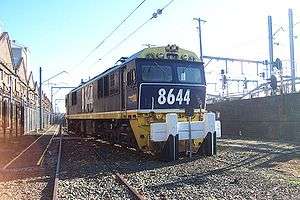New South Wales 86 class locomotive
|
8644 outside Eveleigh Railway Workshops in July 2008 | |||||||||||||||||||||||||||
| |||||||||||||||||||||||||||
| |||||||||||||||||||||||||||
| |||||||||||||||||||||||||||
| |||||||||||||||||||||||||||
The 86 class was a class of electric locomotives built by Comeng, Granville for the State Rail Authority.[1]
History
The 86 class initially hauled passenger and freight services to Lithgow on the Main Western line and Wyong on the Main Northern line. Their sphere of operation extended to Newcastle on the latter line in June 1984 and to Port Kembla in January 1986 when the Illawarra line was electrified.
With a one-hour rating of 4,400 horsepower (hp), the 86 class was the most powerful locomotive in Australia at the time. Although no longer in regular use, the class remains among the most powerful in the country. Despite their higher power rating, they were generally regarded as inferior to the Metropolitan-Vickers built 46 class, which dated from the late 1950s.
The last unit was delivered as a Bo-Bo-Bo as a trial unit.[2] It spent long periods out of traffic undergoing repair.
In 1994/95 all were repainted by A Goninan & Co, Taree into FreightCorp blue.[3] By October 1997 18 had been withdrawn from service with cracked frames.[4] By this stage the amount of work requiring electrics was reducing. National Rail decided it would through haul its services and from March 1998 FreightCorp ceased operating them on Main Northern line services.[5] The need for electrics continued to decline with their remaining duties mainly being hauling coal trains from Lithgow to Port Kembla. The last examples were withdrawn in June 2002.
In 2002, most were sold to Silverton Rail and taken to Broken Hill then sold again in February 2006 to Allco Finance Group with some on sold, but most scrapped.[6][7] Four were leased back to RailCorp in 2004 for use on infrastructure trains during construction of the Bondi Junction turnback.
Survivors
- 8601 & 8650 are owned by the Dorrigo Steam Railway & Museum
- 8606 is owned by the Sydney Electric Train Society, located at the Junee Roundhouse Railway Museum[8]
- 8607 is privately owned, stored outside Junee Roundhouse, to be relocated to the Canberra Railway Museum[9]
- 8609, 8622 & 8649 are all owned by RLG, the former two stored at Lithgow, the latter at Werris Creek
- 8644 is privately owned, stored at Eveleigh Railway Workshops
- 8646 is preserved at the Trainworks Railway Museum, Thirlmere
References
- ↑ Walters, Chris (May 2007). "When They were Young – The 85 and 86 class Electric Locomotives". Australian Railway History. pp. 198–208.
- ↑ "8650" Railway Digest November 1985 page 320
- ↑ "86 Class Repaints" Railway Digest April 1995 page 35
- ↑ "Out of Service" Railway Digest October 1997 page 31
- ↑ "Electric Locos" Railway Digest June 1998 page 35
- ↑ 86 Class Railpage
- ↑ 86 Class Vicsig
- ↑ NSW 86 Class Electric Locomotive 8606 Sydney Electric Train Society
- ↑ Movement of electric locomotive 8607 between Junee and Goulburn Australian Rail Track Corporation 7 March 2016
Further reading
- New South Wales Rail System Locomotives. Sydney: Archives Section, State Rail Authority of New South Wales. 1984.
External links
![]() Media related to New South Wales 86 class locomotives at Wikimedia Commons
Media related to New South Wales 86 class locomotives at Wikimedia Commons
